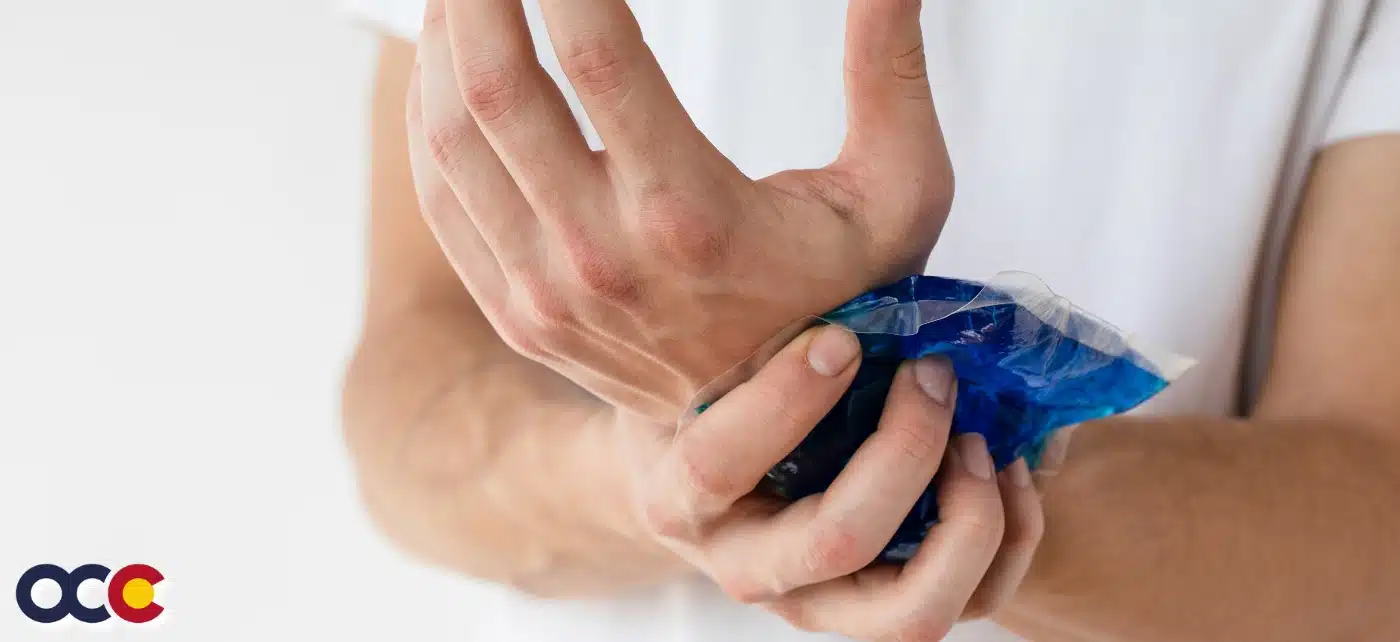It is our natural instinct to brace ourselves when we fall and wrists often pay the price. A wrist sprain is an injury to the ligaments that hold your wrist bones together. Most wrist sprains are minor injuries, that stretch the ligaments further than their limits. But they are usually painful and can be more severe if you tear the ligament. Not properly treating a sprained wrist can lead to further damage not just to the ligaments, but to the cartilage and bones in the wrist. You could suffer increased pain, chronic pain, or arthritis. At OCC – Advanced Orthopedics & Sports Medicine Specialists in Denver, Parker, or Aurora, Colorado, their skilled orthopedic specialists will help you find relief with an accurate diagnosis before the injury leads to debilitating complications.
OVERVIEW
All it takes is a momentary loss of balance. As one slips, it is an automatic impulse to use the hands to catch the fall. However, once the hand hits the ground, the force of the impact bends it back toward the forearm. This stretches the ligaments that connect the wrist and hand too far. The result is tiny tears or even worse, a complete break or tear to the ligament. Wrist sprains can range from mild to severe. There is no specific data on which group of people get the most wrist sprains. They are common injuries in both athletes and non-athletes. They can happen to anyone who takes a fall or gets hit on the wrist, regardless of age, gender, or fitness level. Older adults may be at an increased risk of suffering from wrist sprains due to various health conditions and age-related physical changes. People often confuse a wrist sprain with a wrist strain which is an injury to the tendons.
ABOUT THE WRIST
The wrist, also referred to as the radiocarpal joint, is a complex joint that bridges the hand to the forearm. There are 20 ligaments in the wrist that support eight wrist bones called carpal bones. Ligaments are the connective tissues that connect bones to bones. They could be thought of as tape that holds the bones together at a joint. These ligaments offer stability; when the tissue stretches or tears, the stability of the ligaments and the joints weaken. The carpal bones in the hand attach to the two bones of the forearm: the ulna and radius. They form the carpus, which is the skeletal structure of the wrist joint. The eight bones are arranged in two rows: the proximal row, which is closer to the forearm, and the distal row, which is closer to the hand. They are essential not just for stability but also for flexibility of the wrist joint, allowing for a wide range of movements such as bending, extension, abduction, and adduction. Abduction and adduction at the wrist move the hand away from or toward the midline of the body.
WHAT IS A WRIST SPRAIN?
A wrist sprain is typically caused by a traumatic injury to the wrist, such as a fall onto an outstretched hand, but it can also be from repetitive use of the wrist. Wrist sprains can range from a stretch or tiny tear in the fibers that make up the ligament to a complete tear through the ligament or through its attachment to the bone. There are two types of wrist sprains—radial wrist sprains (on the thumb side of the wrist) and ulnar wrist sprains (on the little finger side of the wrist). Wrist sprains are divided into three grades:
- Pain with minor damage to the ligament
- Pain, more severe ligament damage, a feeling of looseness to the joint, and some loss of function
- Pain, a completely torn ligament, severe looseness to the joint, and loss of function
CAUSES
- Falls onto the hand, in any case, cause the most wrist sprains
- Athletes who engage in sports that involve repetitive movements or high-impact activities such as basketball, gymnastics, baseball, volleyball, skiing, rock climbing, inline skating, racquet sports, golf, and boxing are at increased risk of wrist sprains
- Poor technique during physical activities or sports increases the risk
- Individuals involved in manual labor or occupations that require repetitive wrist motions, heavy lifting, or working with vibrating tools, such as construction workers, mechanics, or carpenters are more prone to wrist sprains
- Older adults may be at higher risk due to age-related changes in bone density and muscle strength which can increase susceptibility to falls or accidents
- People with previous injuries are more likely to get recurrent wrist sprains
- Weak muscles or ligaments surrounding the wrist can predispose individuals to sprains with even minor trauma or strain
SYMPTOMS
Common symptoms include:
- Severe pain
- Swelling
- Tenderness
- Loss of motion
- weakness
- Bruising or discoloration
- Limited mobility in the wrist joint
- Popping or tearing sensation in the wrist
NON-SURGICAL TREATMENTS
Treatment for a sprained wrist includes a mix of rest and restoration of the ligament’s range of motion. Typically, the RICE—rest, ice, compression, and elevation—is advised in the first 24 hours following an injury. It is also advisable to wrap the wrist as soon as possible. A removable splint may be worn to support the wrist. Over-the-counter pain medicines like NSAIDs and acetaminophen can relieve pain and reduce inflammation. Sprained wrist treatment commonly calls for physical therapy, which includes range-of-motion exercises.
WHEN IS SURGERY INDICATED?
For more severe injuries and in cases where the wrist sprain does not respond to conservative treatments, surgery may be required. Surgical options may include:
- Arthroscopy: a minimally invasive procedure where a small camera and surgical Instruments are inserted into the wrist through small incisions. This allows the surgeon to visualize and repair the damaged ligaments.
- Ligament reconstruction: in cases where the ligament is severely torn or detached from the bone, surgery may involve repairing or reconstructing the ligament using stitches or tissue grafts
- Ligament fusion: in rare cases of severe wrist instability or arthritis resulting from a chronic wrist sprain, a fusion may be considered. This involves fusing the bones in the wrist joint together to provide stability and reduce pain.
GETTING THE RIGHT DIAGNOSIS. GETTING THE RIGHT DOCTOR.
Without having a trained professional asses your condition, determining whether your pain is caused by a sprain or a strain can be difficult. X-rays, MRIs, CT scans, or ultrasounds may be used to help gauge the exact nature and severity of the injury. The experienced and accomplished surgeons at Advanced Orthopedics in Denver, Parker, or Aurora, Colorado, utilize innovative treatment methods to diagnose and treat the full spectrum of all types of wrist sprains. Above all, they are well-known for their excellent outcomes. At Advanced Orthopedics, you’ll get first-rate care throughout, because what they care about most is getting you back in the game or just back to what you enjoy doing. If you are suffering from wrist pain, schedule an appointment with a hand and wrist specialist now.










